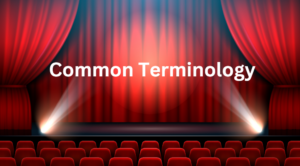
Guy, block, bridge, apron.
You likely know the definition of those words, but they don’t necessarily mean the same thing in the world of theatre and stage rigging. We’ve created a comprehensive glossary of common theatre terms for those new to the industry.
Architectural Stage and Theatre Terms
Auditorium: This part of the theatre is a large open space that accommodates the audience. Stage personnel often refer to this section as the “house.”
Beam: Located in the auditorium ceiling, the beam or beam position is used to house lighting elements that illuminate the front part of the stage.
Foyer: The foyer is part of the auditorium where the audience enters after coming through the lobby. It doesn’t have seats and typically contains the box office, entrance and concession area.
Forestage, or apron: This is a section of a stage that projects into the auditorium past the proscenium.
Green room: This room is located close offstage. Performers, crew and other stagehands use a green room to prepare for a performance.
Lobby: The lobby is the space between the front entrance and ticket booth or box office. It’s the first part of the theatre the audience encounters and can set the tone for their experience.
Loges: This seating area is a balcony with less than seven rows of seats.
Mezzanine: The mezzanine is a flat seating area located underneath a balcony or the lowest balconies in a larger theatre.
Proscenium arch: Sometimes called the proscenium, this is the opening through which the audience views the performance. It may be simple or more ornate to contrast with the surrounding walls.
Proscenium line: This is an imaginary line where the proscenium arch meets the stage floor.
Proscenium wall: This wall separates the auditorium and audience from the stage and supports the proscenium arch.
Stage: This portion of the theatre includes the performance area and side and rear spaces used for handling different types of stage equipment.
Theatre: This is the building that houses the lobby, foyer, auditorium and stage.
Working stage: The setup that includes scenic and visual elements like drapes and drops that are lowered to half the height of the proscenium or more than 10 feet.
Structural Stage and Theatre Terms
Bracer beam: This steel beam secures the stage-side head block beam and reinforces the structure of the stage.
Bridge: A walkway located above the proscenium, a bridge spans the length of the stage to support lighting equipment and may be suspended with counterweight systems.
Fly rope: The ropes used in a fly system are located on the fly floor and allow crew members to hoist and lower suspended elements.
Grid, gridiron and gridiron floor: This above-stage structure supports the pulleys and other hardware needed to hoist and lower equipment.
Loading floor: This platform is suspended about eight feet below the grid. Weights in a counterweight system are changed on the loading floor to keep equipment balanced.
Lock rail floor: Sometimes suspended or at stage level, the lock rail floor is the platform from which counterweight rigging is lifted and lowered.
Loft: The loft is the space between the grid and the roof of the theatre and can be used to house rigging systems and equipment.
Under-hung grid: This type of grid has rigging blocks mounted on the bottom of the structure to support the movement of scenery, curtains and lights.
Up-right grid: The blocks are mounted on the top of this type of grid to manage the fly system.
Well: This is the space between grid beams that allows cables to pass through.
Theatre and Stage Rigging Terms
Batten: This is a pipe suspended over the stage that handles drapes, scenery, drops and lighting. Smaller battens are called “jack battens.”
Block: A block is a protective structure that contains a sheave and axle.
Bridle: This is a V-shaped connection attached to two points on a grid to support a batten.
Guy: A guy is a tensioned cable, chain or rope used to stabilize battens and free-standing structures.
Purchase line, or operating line: A purchase line is a type of rope used for operating a track. Power systems use steel cables or wire center purchase lines.
Sheave: This is a grooved wheel that supports a cable or rope in a pulley system.
Traveler track: A traveler track holds a two-piece drape with two pulleys on one side (live) and one pulley on the other (dead).
Custom Theatre and Stage Rigging at Tiffin Scenic
We’re committed to crafting unique custom rigging solutions for theatres
of all sizes. Tiffin Scenic Studios specializes in design, installation and safety inspections to ensure your productions go off without a hitch. Review our portfolio and contact our team to schedule a consultation.